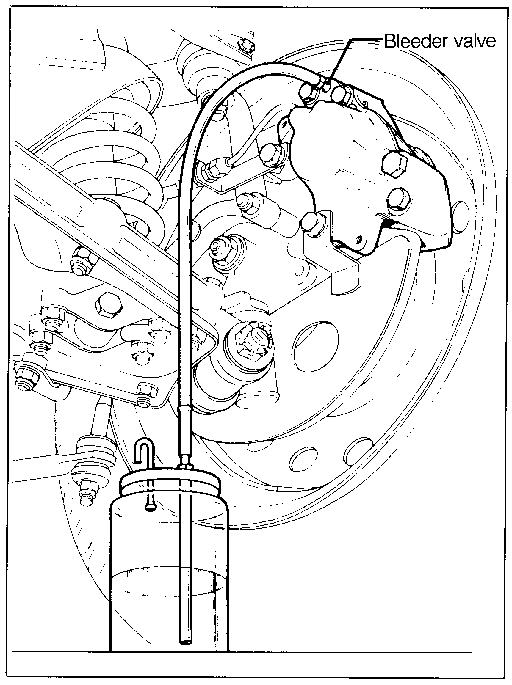4.2 Bleeding Brakes (all systems, including ABS)Bleeding brakes is the process of purging air bubbles or contaminated brake fluid from the system and replacing it with new, clean brake fluid. Bleeding the brakes periodically is good preventive maintenance, but it is also essential if brake lines or components have been disconnected, or any time air is introduced into the system. Vague or spongy brakes may indicate the need to bleed air from the system.
There are three widely used methods of bleeding brakes. All involve some means of forcing the fluid through the system, and releasing the contaminated fluid through the bleeder valves at the calipers or wheel cylinders. The system can be bled using a pressure bleeder, using a hand-held vacuum bleeder, or manually using a helper to pressurize the system using the brake pedal. Each method accomplishes the same result. Pressure bleeding, if the equipment is available, is fastest. Manual bleeding requires a helper, but it is easy and requires no special tools. For the best possible results, bleeding by any method should start at the wheel farthest from the master cylinder and end at the wheel closest to the master cylinder. Thus, the correct bleeding sequence is as follows:
For best access to the bleeder valves when bleeding the brakes, the car should be raised and firmly supported on jack stands which are designed for the job. The engine should be off and the vacuum hose and check valve should be disconnected from the vacuum booster. On models equipped with the load-sensing pressure regulator, the actuator lever must be held toward the axle beam (toward the rear of the car) when bleeding the rear brakes to allow maximum fluid flow. The bleeder valves on both disc brake calipers and drum brake wheel cylinders are opened and closed using a small box wrench. Avoid using an open-end wrench, as it can easily slip off and damage the hex portion of the screw. Use a clear container to catch the expelled fluid. Attach a piece of clear, flexible tubing (4 mm or 5/32 in. inside diameter) to the bleeder valve, as shown in Fig. 4-1, so that outgoing air bubbles are visible.

|